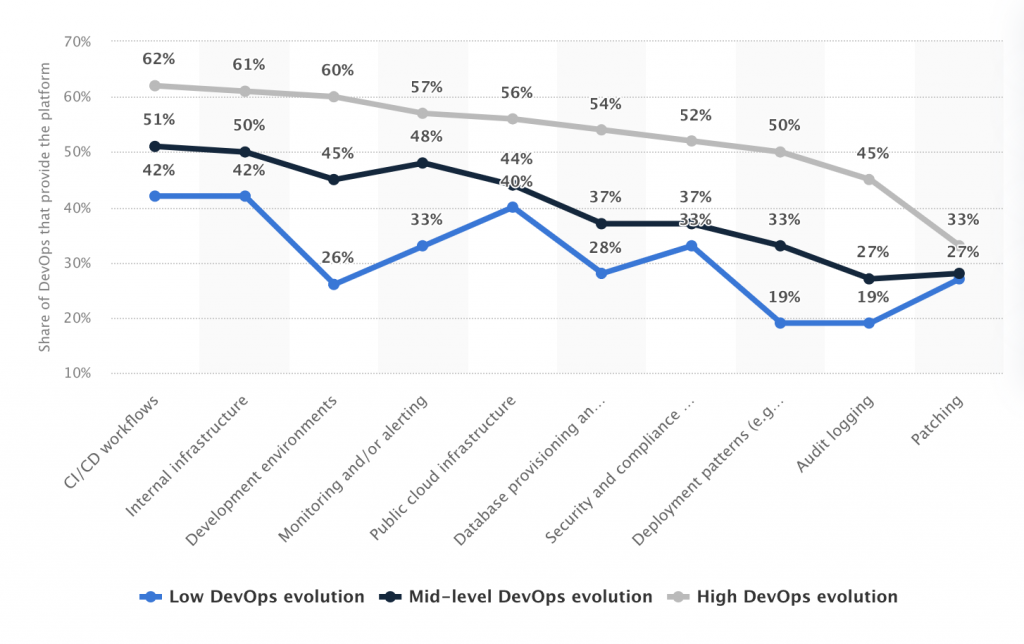Introduction
In the dynamic landscape of software development, the integration of Development and Operations, commonly known as DevOps, has emerged as a game-changer. However, this innovative approach isn’t without its hurdles, especially for DevOps developers in the USA. This article delves into the unique challenges faced by DevOps professionals in the United States and offers insightful strategies to overcome them. Let’s embark on a journey through the intricate web of DevOps challenges and their solutions.
Understanding DevOps Challenges

Source: Statista – DevOps evolution
In the fast-paced realm of modern software development, the fusion of Development and Operations, known as DevOps, has emerged as a revolutionary approach to streamline workflows and enhance collaboration. However, as with any substantial transformation, DevOps is not exempt from challenges. The very nature of harmonizing two traditionally separate domains comes with a set of intricate hurdles that DevOps developers, particularly in the United States, must adeptly navigate.
At its core, DevOps seeks to dissolve silos between development and operations teams, fostering a culture of collaboration, transparency, and rapid iteration. This ambitious endeavor to merge previously distinct functions brings about a series of complex challenges that merit careful consideration. One of the foundational hurdles lies in orchestrating an environment where code is seamlessly developed, tested, and deployed, all while maintaining compatibility with an ever-evolving technological landscape. This requires not only continuous integration of new tools and platforms but also the adept management of compatibility concerns, ensuring that the DevOps pipeline remains stable and efficient. Another pivotal challenge surfaces in the form of team dynamics, as disparities in skill levels and competencies among team members can impede the smooth flow of communication and execution.
Navigating Key DevOps Challenges: Expert Solutions for Seamless Integration

Challenge 1: Dynamic Tech Landscape
The USA’s tech landscape is a whirlwind of rapid advancements and innovations. The challenge lies in keeping pace with this dynamic evolution while ensuring that DevOps practices remain relevant and effective. Stagnation can quickly lead to obsolescence, making it imperative for DevOps teams to embrace change without disrupting their workflows.
Solution: To thrive in the dynamic tech landscape, organizations should foster a culture of continuous learning and adaptation. Encourage team members to dedicate time to explore emerging technologies and trends, allowing them to bring fresh insights to the organization. Implement regular technology reviews to assess the relevance and efficiency of existing tools and processes. Embrace experimentation and pilot projects that test the viability of new technologies within the DevOps context. Establish partnerships with technology vendors and industry thought leaders to gain early access to upcoming trends and innovations. Maintain a flexible architecture that can accommodate new tools and technologies seamlessly. Prioritize cross-functional collaboration to ensure that developers and operations teams are aligned on adopting new technologies. By embracing the fluidity of the tech landscape organizations can harness the potential of innovation while keeping their DevOps practices on the cutting edge.
Challenge 2: Talent Scarcity
In the competitive tech landscape of the USA, the challenge of finding and retaining skilled DevOps professionals is a growing concern. The demand for DevOps expertise often outpaces the supply, making recruitment and retention an uphill battle. This scarcity intensifies the need for innovative talent management strategies that not only attract but also nurture and empower DevOps professionals.
Solution: To tackle talent scarcity, organizations must adopt a multi-faceted approach. Begin by creating an attractive workplace culture that emphasizes learning, growth, and work-life balance. Offer continuous learning opportunities, whether through workshops, certifications, or conferences, to keep the team’s skills current and relevant. Develop personalized career paths that align with each individual’s goals and aspirations, fostering a sense of ownership and commitment. Establish mentorship programs that pair experienced professionals with newcomers, facilitating knowledge transfer and skill development. Leverage remote work and flexible schedules to tap into a wider talent pool beyond geographic limitations. Additionally, collaborate with educational institutions to offer internships and co-op programs, nurturing talent from the ground up. Recognize and reward achievements, creating a sense of fulfillment and loyalty among team members. By embracing a people-centric approach, organizations can not only overcome the challenge of talent scarcity but also create an environment where professionals thrive and contribute their best.
Challenge 3: Vendor and Tool Diversity
The expansive tech market in the USA offers a plethora of tools and vendors catering to various DevOps needs. However, the challenge lies in selecting, integrating, and managing these tools effectively to ensure seamless DevOps operations. The wrong choices can lead to inefficiencies, compatibility issues, and increased complexity.
Solution: Overcoming the challenge of vendor and tool diversity requires a strategic approach to tool selection and integration. Begin by conducting a thorough assessment of the organization’s specific needs and priorities. Develop a clear roadmap that outlines the desired toolchain and its integration points. Prioritize tools that offer robust integration capabilities and are well-supported by their vendors. Establish clear criteria for tool evaluation, considering factors such as ease of use, scalability, community support, and alignment with the organization’s technology stack. Implement a proof of concept (POC) phase for new tools to validate their compatibility and effectiveness in a controlled environment. Utilize automation to streamline tool integration and reduce manual effort. Develop standardized workflows and documentation for tool usage, ensuring consistency across the team. Regularly review and update the toolchain to align with emerging needs and technological advancements. By adopting a methodical and strategic approach to managing vendor and tool diversity, organizations can create a harmonious DevOps ecosystem that fosters efficiency and innovation.
Challenge 4: Dealing with Obsolete Practices
Transitioning from traditional practices to modern DevOps methodologies can be a daunting journey, often hindered by resistance to change. Obsolete practices that were once effective might become barriers to agility and innovation, slowing down the overall development process and impeding the seamless adoption of DevOps principles.
Solution: Overcoming this challenge requires a combination of strategic planning, effective communication, and a phased approach to change. Start by fostering a clear understanding of the benefits of DevOps among stakeholders. Highlight how these benefits align with the organization’s goals and contribute to faster time-to-market and improved quality. Create a detailed roadmap for the transition, breaking it into manageable phases. This approach reduces the shock of abrupt change and allows teams to adapt gradually. Encourage cross-functional collaboration by forming DevOps task forces that consist of representatives from different departments. These task forces can collaborate on designing and implementing the transition, ensuring a shared sense of ownership. Pilot DevOps practices on a smaller scale to demonstrate their effectiveness before implementing them organization-wide. Regularly communicate progress and successes to all stakeholders, reinforcing the positive outcomes of the transition. By creating a culture that values innovation, embraces change, and celebrates wins, organizations can successfully move away from obsolete practices and thrive in the DevOps ecosystem.
Challenge 5: Security Issues
Incorporating security seamlessly into the DevOps process presents a critical challenge. DevOps’s emphasis on speed and automation can sometimes lead to security being treated as an afterthought, leaving applications vulnerable to threats and breaches.
Solution: A robust security-first approach is vital to addressing this challenge. Begin by integrating security professionals early in the development process, breaking down silos between security and development teams. Conduct regular security assessments and vulnerability scans throughout the development lifecycle, from code creation to deployment. Implement automated security testing as part of the CI/CD pipeline, ensuring that security checks are consistent and reliable. Embrace the principle of “shift-left” security, where security concerns are addressed as early as possible in the development process. This approach reduces the chances of vulnerabilities making their way into the final product. Employ security training and awareness programs for all team members to instill a security-focused mindset. Utilize tools that facilitate secure coding practices and provide real-time feedback to developers. Lastly, regularly audit and update security policies and procedures to adapt to new threats and challenges. By integrating security into the DevOps DNA, organizations can confidently deliver software that is both rapid and secure.
Challenge 6: Regulatory Considerations
Navigating the intricate landscape of regulatory frameworks unique to the USA can present a significant challenge for DevOps teams. Ensuring compliance while maintaining agility demands careful planning and an in-depth understanding of industry-specific regulations.
Solution: The key to overcoming this challenge is meticulous compliance planning from the outset. Begin by conducting a thorough assessment of all applicable regulations in the industry and region. This assessment should be an ongoing process, adapting to changes in regulations. Establish clear compliance guidelines and protocols that align with DevOps practices. Collaborate closely with legal and compliance experts to interpret and implement regulatory requirements within the DevOps pipeline. Leverage automation to ensure that compliance checks are consistent and accurate, minimizing the risk of human error. Regularly audit the compliance processes to identify gaps and areas for improvement. Establish clear documentation and reporting procedures to demonstrate compliance to auditors or regulatory bodies. Lastly, foster a culture of compliance awareness among all team members to ensure that adherence to regulations becomes an inherent part of the DevOps workflow. With a comprehensive strategy in place, DevOps teams can navigate the regulatory landscape with confidence.
Challenge 7: Team Maturity and Competence
The challenge of mismatched skill sets within DevOps teams can create roadblocks in achieving the seamless collaboration that DevOps advocates. Efficient communication and workflow require team members to possess a common understanding of DevOps principles, practices, and tools. The absence of a unified skill set can lead to misaligned expectations and hinder the team’s ability to deliver high-quality software consistently.
Solution: Addressing this challenge starts with investing in continuous training and upskilling initiatives. Conduct regular skill assessments to identify gaps and tailor training programs accordingly. Encourage cross-functional collaboration and knowledge sharing to level the playing field and foster a culture of collective growth. Implement mentorship programs where experienced team members guide those with less experience. This approach not only enhances skill development but also promotes effective communication and cooperation. To ensure cohesive collaboration, rotate team members between different roles within the DevOps cycle. This not only broadens skill sets but also builds empathy for the challenges faced by other team members. Furthermore, employ tools that facilitate knowledge sharing and collaboration, such as wikis, chat platforms, and internal forums. Ultimately, a team that embodies a mix of expertise and a shared commitment to learning can overcome this challenge and flourish in the DevOps landscape.
Also read: How to evaluate a DevOps consulting company in the USA
Adopting DevOps Successfully

The successful adoption of DevOps transcends mere technological implementation; it’s a cultural transformation that permeates every facet of an organization. Embracing DevOps means embracing collaboration, automation, and a mindset focused on continuous improvement. To achieve this transformation, organizations must navigate a path that encompasses both people and processes.
At its core, adopting DevOps requires a shift in mindset—one that places a premium on collaboration and shared responsibility. Silos between development and operations teams must be dismantled, replaced by a cohesive unit that collectively takes ownership of the entire software delivery lifecycle. This shift in culture entails fostering an environment where open communication, trust, and transparency flourish. Alongside this cultural shift, automation becomes the backbone of a successful DevOps implementation. Manual, error-prone tasks are automated, enabling rapid, consistent, and reliable software delivery. This not only accelerates the release cycle but also frees up human resources for more strategic and creative endeavors. Automation should extend across the development pipeline, encompassing testing, deployment, infrastructure provisioning, and monitoring. However, successful adoption goes beyond mere tool implementation; it requires a deep-rooted commitment to continuous improvement.
Real-Life Examples

Real-world success stories provide invaluable insights into overcoming DevOps challenges and achieving remarkable outcomes. Let’s delve into a couple of real-life examples that showcase how organizations in the USA conquered DevOps hurdles and reaped the rewards of their efforts.
Example 1: Geekyants’s CI/CD Transformation
GeekyAnts, an ambitious DevOps consulting venture company in the USA faced the challenge of a sluggish Continuous Integration and Continuous Deployment (CI/CD) pipeline, leading to delayed releases and frustrated teams. To overcome this, they embarked on a CI/CD transformation journey. The company introduced automation at every stage of their pipeline, from code commit to production deployment. By doing so, they not only reduced manual intervention but also gained faster feedback cycles, which translated into quicker bug identification and resolution. Additionally, they implemented a comprehensive monitoring system that enabled them to identify bottlenecks and performance issues early on. This strategic shift to a streamlined and automated CI/CD pipeline not only improved the delivery speed but also elevated the quality of their software and market competitiveness.
The firm’s strategy focused on two key pillars: automation and continuous improvement. By automating various stages of their development, testing, and deployment process, they significantly reduced manual interventions, cutting down the chances of human errors and bottlenecks. This automation allowed their development teams to focus more on crafting quality code and less on tedious, repetitive tasks. Their CI/CD transformation not only catapulted their release cycle speed but also elevated their reputation in the competitive e-commerce market. The startup’s success story underscores the profound impact that DevOps principles can have on even emerging players, demonstrating that a proactive can lead to impressive outcomes.
Example 2: Mission Cloud’s Regulatory DevOps
A leading software firm in the USA faced the complex challenge of integrating stringent regulatory requirements with a swift DevOps workflow. They navigated this challenge by establishing a cross-functional team that consisted of not only DevOps professionals but also compliance experts. This team worked collaboratively to map out the compliance requirements specific to the industry and incorporated them into the DevOps pipeline. By leveraging automation and integrating compliance checks at every stage, they ensured that their software adhered to regulatory standards without compromising on speed. This approach not only enabled them to maintain compliance but also positioned them as a pioneer in regulatory DevOps practices within the sector.
Example 3: XenonStack’s Security-First DevOps
Emerging technology solutions company embraced a “security-first” DevOps strategy to infuse stringent security practices into its software development process. By prioritizing security across the entire development lifecycle, XenonStack fortified its applications against threats while maintaining its rapid delivery cycle. This approach not only solidified its commitment to data protection but also positioned the startup as a trusted contender in the competitive fintech sector.
These real-life examples demonstrate the transformative power of DevOps when tailored to an organization’s unique challenges. By strategically addressing their obstacles and embracing innovative solutions, these companies achieved remarkable results that reverberate through their efficiency. These stories of success underscore the importance of a tailored DevOps approach that aligns with an organization’s goals and industry context.
Also read: Finding the Perfect Fit: Hiring Dedicated DevOps Developers in the USA
Conclusion
Real-world examples serve as inspiring testaments to the power of DevOps in transforming organizations, whether they’re established giants or emerging startups. Through their endeavors, these organizations demonstrate the potential of DevOps to reshape processes, enhance efficiency, and elevate outcomes. Their stories underscore the pivotal role of strategic planning, adaptability, and a commitment to continuous improvement in driving successful DevOps adoption.
As industries in the USA and beyond continue to embrace the DevOps paradigm, it becomes evident that there is no one-size-fits-all solution. Each organization must tailor its approach to align with its unique goals, industry context, and existing practices. The insights gained from understanding both common and unique challenges shed light on the importance of continuous learning, collaboration, and fostering a culture of innovation.



















